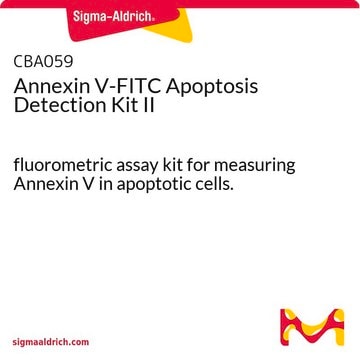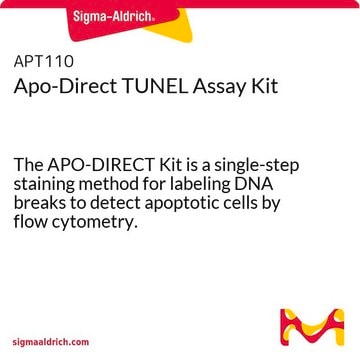APOAC
Annexin V-Cy3™ Apoptosis Detection Kit
Synonym(s):
Red fluorescent Annexin V apoptosis assay
About This Item
Recommended Products
usage
sufficient for 200 tests
Quality Level
packaging
pkg of 1 kit
technique(s)
flow cytometry: suitable
application(s)
cell analysis
detection
detection method
fluorometric
shipped in
wet ice
storage temp.
2-8°C
Features and Benefits
- Rapid labeling of cells. Cell staining takes only 10 minutes.
- No cell fixation or processing required, reducing the detection time and allowing the cells to be used for further study.
- 6-Carboxyfluorescein diacetate secondary dye is included with the kit to differentiate apoptotic cells from viable and necrotic cells.
Principle
Legal Information
Kit Components Only
- Annexin V Cy3.18 Conjugate from human placenta, buffered aqueous solution 10 μg
Kit Components Also Available Separately
- C50416-Carboxyfluorescein diacetate 10 mgSDS
Storage Class Code
10 - Combustible liquids
Flash Point(F)
Not applicable
Flash Point(C)
Not applicable
Certificates of Analysis (COA)
Search for Certificates of Analysis (COA) by entering the products Lot/Batch Number. Lot and Batch Numbers can be found on a product’s label following the words ‘Lot’ or ‘Batch’.
Already Own This Product?
Find documentation for the products that you have recently purchased in the Document Library.
Articles
Cellular apoptosis assays to detect programmed cell death using Annexin V, Caspase and TUNEL DNA fragmentation assays.
Cellular apoptosis assays to detect programmed cell death using Annexin V, Caspase and TUNEL DNA fragmentation assays.
Cellular apoptosis assays to detect programmed cell death using Annexin V, Caspase and TUNEL DNA fragmentation assays.
Cellular apoptosis assays to detect programmed cell death using Annexin V, Caspase and TUNEL DNA fragmentation assays.
Our team of scientists has experience in all areas of research including Life Science, Material Science, Chemical Synthesis, Chromatography, Analytical and many others.
Contact Technical Service








